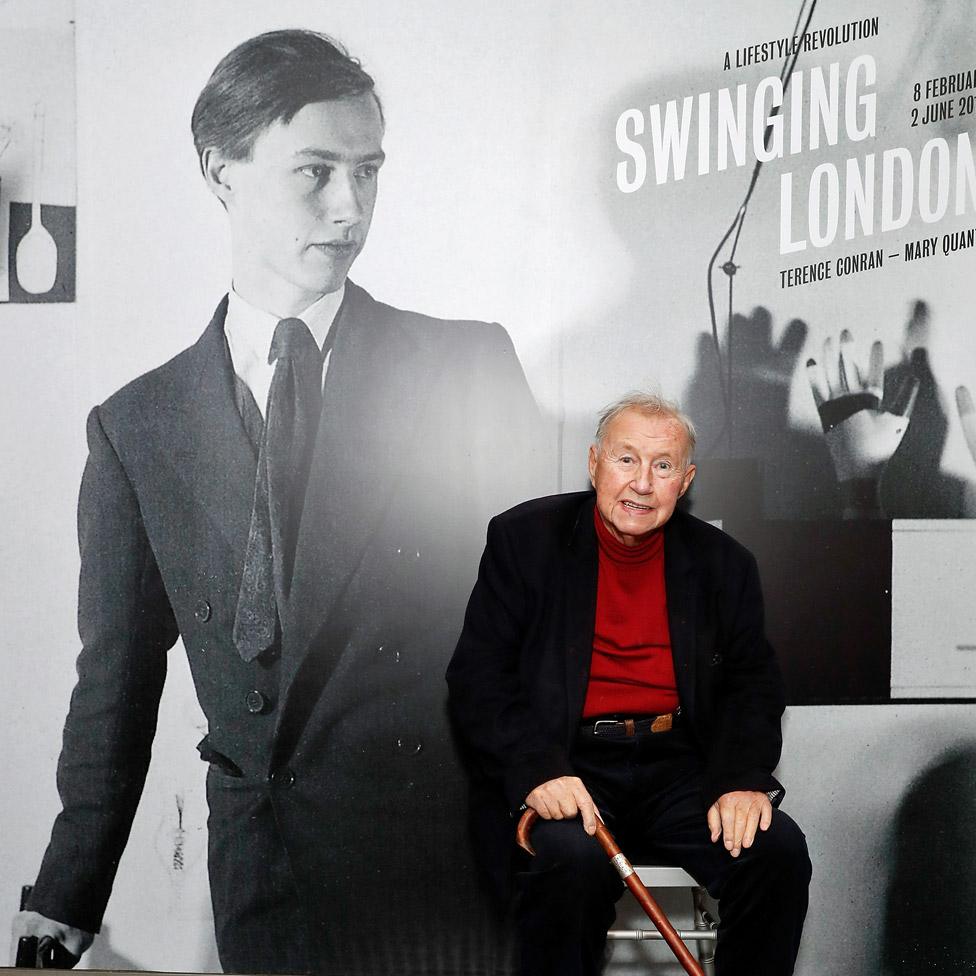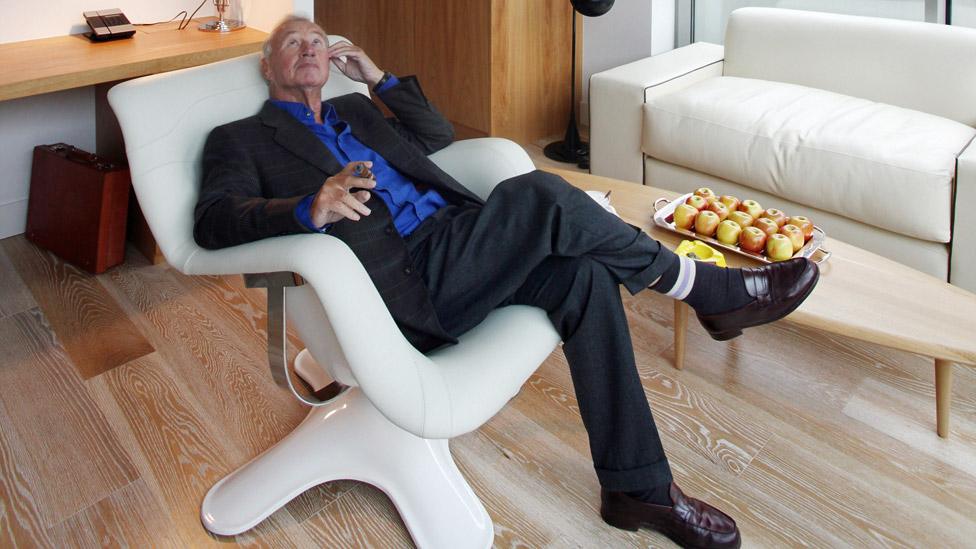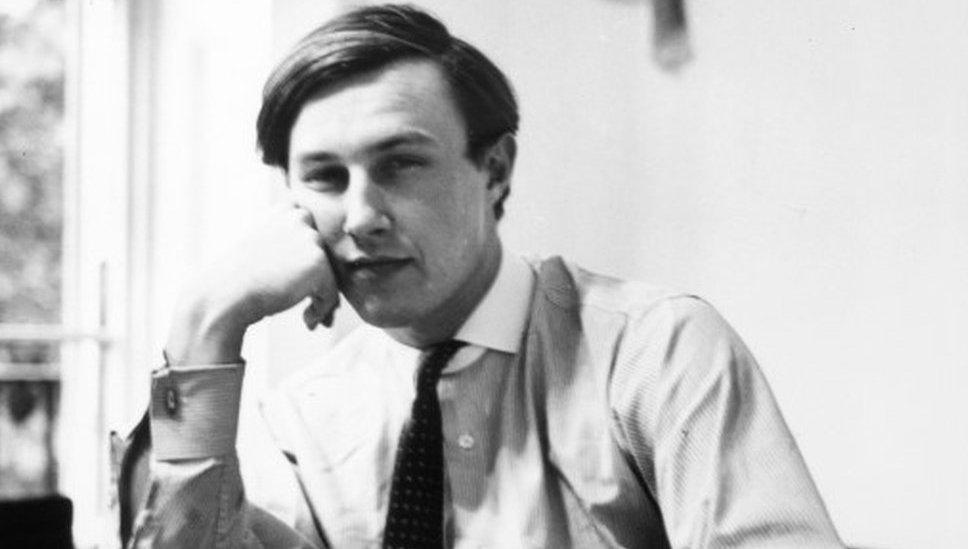Sir Terence Conran: 'Visionary' designer dies at 88
- Published

Sir Terence's empire spanned restaurants, furniture and architecture
Sir Terence Conran, the British designer who revolutionised retail and decor, has died at the age of 88.
Best known as the founder of Habitat, he brought modern style and simplicity to UK homes in the 1960s and later helped found the Design Museum.
"He was a visionary who enjoyed an extraordinary life and career that revolutionised the way we live in Britain," said a family statement.
"He was adored by his family and friends and we will miss him dearly."

Sir Terence at the launch of the Swinging London exhibition at the Fashion and Textile Museum in 2019
The statement added: "It gives us great comfort to know that many of you will mourn with us but we ask that you celebrate Terence's extraordinary legacy and contribution to the country he loved so dearly."
He "promoted the best of British design, culture and the arts around the world", with "a very simple belief that good design improves the quality of people's lives".
Sir Terence started his career in the late 1940s, but became a household name as one of the key designers of the swinging '60s.
His empire would go on to span restaurants, architecture and household retail brands including Mothercare, but it was for his accessible and fashionable furniture, interiors and homeware that he remains best-known.

Pictured in the Terence Conran Suite at Boundary in Shoreditch in 2009
He pioneered flat-pack furniture years before Ikea arrived on British shores, helping to lower the prices of his cutting-edge designs in his bid to "democratise good design".
Design Museum director Tim Marlow led the tributes, saying it was "a privilege and an inspiration to know him".
In a statement, Marlow wrote: "Terence Conran was instrumental in the re-designing of post-war Britain and his legacy is huge.
'Extraordinary life'
"He is revered by generations of designers, from Mary Quant and David Mellor to Thomas Heatherwick and Jonny Ive.
"He changed the way we lived and shopped and ate. He also created a great institution - the Design Museum - of which he was justifiably proud and with which he remained fully engaged right to the end of his extraordinary life."
Designer and architect George Clarke, gardener and broadcaster Monty Don, and restaurant critic Marina O'Loughlin were among others paying tribute.
Allow X content?
This article contains content provided by X. We ask for your permission before anything is loaded, as they may be using cookies and other technologies. You may want to read X’s cookie policy, external and privacy policy, external before accepting. To view this content choose ‘accept and continue’.

Allow X content?
This article contains content provided by X. We ask for your permission before anything is loaded, as they may be using cookies and other technologies. You may want to read X’s cookie policy, external and privacy policy, external before accepting. To view this content choose ‘accept and continue’.

Allow X content?
This article contains content provided by X. We ask for your permission before anything is loaded, as they may be using cookies and other technologies. You may want to read X’s cookie policy, external and privacy policy, external before accepting. To view this content choose ‘accept and continue’.

After studying textile design and setting up his own furniture studio, Conran joined an architectural firm in 1950 and worked on the subsequent year's Festival of Britain.
As the '50s went on, his ambitious and wide-ranging approach to design and business became clear. A furniture workshop, a French-inspired restaurant and a coffee shop eventually led him to form the Conran Design Group. The company also designed interiors and retail spaces, including a shop for pioneering '60s fashion designer Quant.
Conran opened the first Habitat store on the Fulham Road in 1964, selling taste-making and trend-setting furniture, art, home and cookery products to a burgeoning young clientele who wanted to break from drab post-war austerity.

Shoppers in a Habitat store in 1973
"It is hard to overstate how uninteresting London was then," he later said. "You could go along a terrace of houses, and every living room you looked in was the exactly the same, with the same extremely dreary furniture."
Conran was heavily influenced by continental European styles, and is credited with introducing duvets to Britain.
Habitat rapidly expanded across the UK, and he went on to take over Mothercare and British Home Stores, as well as running other ventures, such as his extensive and influential restaurant business - including Bibendum and Quaglino's - and The Conran Shop. He also wrote numerous books about design and food.
"The restaurants, hotels and bars we have designed or operated, the shops, the interiors, the buildings, the products and furniture or the books I have written - design is the one thing that connects them all and they add up to what I call a style of life," he said.
He was married four times, including to Shirley Conran, who helped launch Conran Design before becoming the author of self-help books like Superwoman and the racy bestseller Lace.
Their sons Jasper and Sebastian Conran both became designers, while his other three children - Tom, Sophie and Ned - by his third wife, food writer Caroline, have forged successful careers in the creative sector, notably in food writing and as restaurateurs.
- Published12 September 2020
